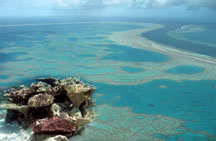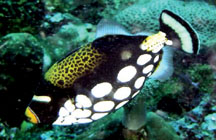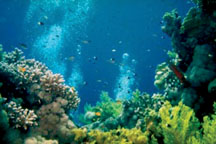
The largest structure built by living organisms
In our last Geo Facts page, we introduced you to the fascinating
world of corals. We spoke about a coral reef in Sri Lanka. Today, we
feature the most famous coral reef in the world, the Great Barrier Reef
of Australia.

This is the largest structure on the planet built by living
organisms. This coral rampart (wall) hosts a carnival of sea life. The
Great Barrier Reef is undisputed as one of the world's most important
natural assets. It is the largest natural feature on Earth, stretching
more than 2,300km along the north east coast of Australia, from the
northern tip of Queensland to north of Bundaberg.
The Great Barrier Reef Marine Park includes about 900 islands. Of
these, 618 are continental islands and 300 are coral cays, of which 230
are vegetated.
Animals
The Great Barrier Reef is the best example for a place with a large
bio-diversity. It is home to an amazing variety of fascinating animals,
which live on the Reef's many islands, on the shore and under water.

Most of us are familiar with the colourful corals and the beautiful
bright fish; other creatures on the Reef are just as intriguing
(interesting). The variety of organisms found beneath a coral rock is
astonishing, ranging from different types of colourful encrusting
(forming a crust on top) sponges, softer colonial (living in colonies)
and solitary sea squirts to delicate lace corals or bryozoans,
slithering serpent stars and worms, and scores of colourful and oddly
shaped animals.
This Reef is like a big city. Various kinds of animals and plants are
living there, minding their own business. It is a very complex
eco-system. Many animals rely on each other for their food and survival.
Virtually all major and minor groups of living things are abundantly
represented in the Reef. Only tropical rainforests like Amazon can come
close to rivalling the Reef for its richness of species.

Marine animals on the Great Barrier Reef include 350 types of hard
coral, 5,000 to 8,000 molluscs and thousands of different sponges,
worms, crustaceans, and other less familiar creatures, 1,500 species of
fishes, about 800 species of echinoderms (starfish, sea urchins), 22
species of seabirds that live and breed on the islands within the marine
park, more than 30 species of marine mammals, and six species of marine
turtles, all listed as threatened.
The Reef is also the breeding area for a number of rare and
endangered animal species. Humpback whales come from Antarctica to give
birth to their young in the Reef waters. Six of the world's seven
species of sea turtles breed on the Reef, and dugongs make their home
within the sheltered seagrass beds.
Plants
That's enough about the animals in the Reef. Let's take a look at the
plants which survive there. The area is home to, between 400 and 500
species of marine algae. Red and brown algae live in the inshore parts
of the Reef, while red and green algae live in offshore areas. The park
has the most extensive beds of Halimeda algae in the world.
Mangroves are another variety that makes the Reef beautiful. It is
extremely important as a spawning ground and as a nursery for many Reef
species. The park is home to 37 mangrove varieties, representing 57 per
cent of all the world's mangroves. The park's 15 species of seagrasses
are also very important to animals such as turtles and dugongs.
Of the 2,195 plant species found on the 618 continental islands of
the Reef, three are found nowhere else. There are between 300 and 350
species on coral cays in the north of the marine park and 120 species in
the south. The Whitsunday Islands are the most botanically diverse area
in the park with 1,141 species recorded. More than 70 species in the
park are listed as rare or threatened under the Queensland and
Commonwealth legislation, and in the IUCN Red Book. This, as we
mentioned earlier, is truly a paradise. It's like another world. Imagine
you being a starfish and living in this Reef? Amazing isn't it?
Compiled by Janani Amarasekara. |


